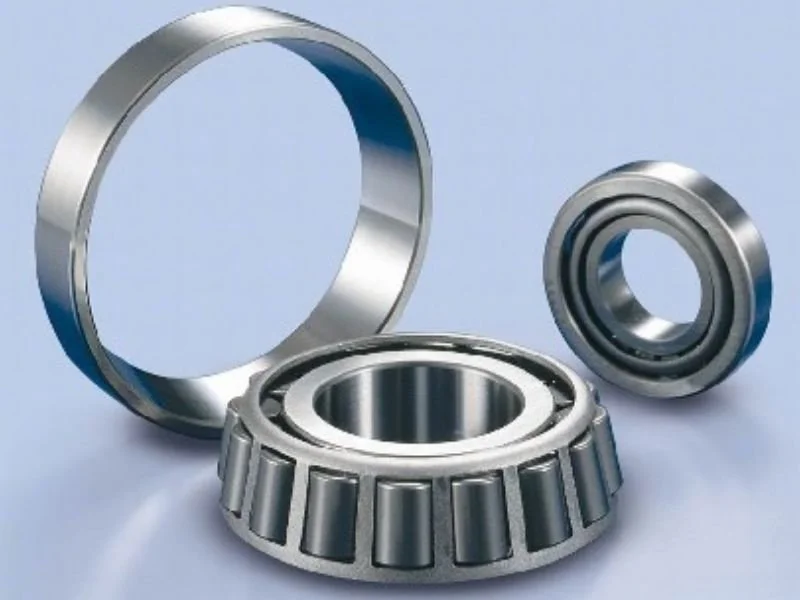Conical Bearing Materials: Which Alloys Offer the Best Performance?
Conical bearings, also known as tapered roller bearings, are crucial components in various industrial applications, providing exceptional support for both radial and axial loads. The performance and longevity of these bearings are heavily dependent on the materials used in their construction. In this comprehensive exploration, we delve into the world of conical bearing materials, focusing on the alloys that offer superior performance. As industries continue to demand higher efficiency and durability from their machinery, the choice of bearing material becomes increasingly critical. From traditional steel alloys to advanced ceramic composites, we'll examine how different materials impact the load-bearing capacity, wear resistance, and overall lifespan of conical bearings. This analysis will help engineers, manufacturers, and industry professionals make informed decisions when selecting the most suitable materials for their specific applications, ultimately leading to improved machine performance and reduced maintenance costs.
What are the Key Factors in Choosing Conical Bearing Materials?
Load-Bearing Capacity
When selecting materials for conical bearings, load-bearing capacity is a paramount consideration. Conical bearings are often subjected to intense radial and axial forces, necessitating materials that can withstand these pressures without deformation or failure. High-strength alloys, such as chrome steel (GCr15) and case-hardened steel, are popular choices due to their excellent load-bearing properties. These materials exhibit high hardness and toughness, allowing conical bearings to maintain their shape and function under extreme loads. Additionally, the microstructure of these alloys can be optimized through heat treatment processes, further enhancing their load-bearing capacity. For applications involving even higher loads, advanced alloys like carburized steel (G20Cr2Ni4A) may be employed, offering superior strength and durability for conical bearings in heavy-duty machinery.
Wear Resistance
Wear resistance is another crucial factor in the selection of conical bearing materials. As these bearings operate under continuous rolling and sliding contact, the ability to resist wear is essential for maintaining performance and extending service life. Materials like GCr15SiMn, a high-carbon chromium bearing steel with added silicon and manganese, offer excellent wear resistance properties. The addition of these elements enhances the material's hardness and improves its ability to form a protective oxide layer, reducing wear during operation. For conical bearings used in particularly abrasive environments, surface treatments such as nitriding or the application of ceramic coatings can significantly boost wear resistance. These treatments create a hard, wear-resistant surface layer on the bearing, protecting the underlying material from abrasion and extending the overall lifespan of the conical bearing.
Corrosion Resistance
Corrosion resistance is an often overlooked but critical factor in choosing conical bearing materials, especially for applications in corrosive environments. Stainless steel alloys, such as 440C, are frequently used in conical bearings where corrosion resistance is a priority. These materials contain high levels of chromium, which forms a passive oxide layer, protecting the bearing from chemical attack. For even more demanding environments, conical bearings may be manufactured from highly corrosion-resistant alloys like Inconel or Hastelloy. While these materials may come at a higher cost, they ensure the longevity and reliability of conical bearings in harsh chemical or marine environments. Additionally, the use of corrosion-resistant materials can reduce the need for frequent maintenance and replacement, ultimately lowering the total cost of ownership for machinery employing these specialized conical bearings.

How Do Different Alloys Compare in Conical Bearing Performance?
Chrome Steel vs. Case-Hardened Steel
In the realm of conical bearings, the choice between chrome steel and case-hardened steel often comes down to specific application requirements. Chrome steel, such as GCr15, is widely used in conical bearings due to its excellent hardness and wear resistance. Its high chromium content allows for through-hardening, resulting in a uniform hardness throughout the bearing. This makes chrome steel conical bearings ideal for applications with high loads and moderate speeds. On the other hand, case-hardened steel, like G20Cr2Ni4A, offers a unique combination of a hard surface with a tough core. The case-hardening process creates a wear-resistant outer layer while maintaining a ductile interior, making these conical bearings suitable for applications with shock loads or sudden impacts. The choice between these alloys for conical bearings often depends on factors such as load characteristics, operating speeds, and the potential for impact loads in the application.
Stainless Steel vs. Ceramic Materials
The comparison between stainless steel and ceramic materials in conical bearings presents an interesting contrast in performance characteristics. Stainless steel, particularly grades like 440C, offers good corrosion resistance and adequate hardness for many conical bearing applications. Its ability to resist rust and chemical attack makes it a popular choice for conical bearings in food processing, pharmaceutical, and marine environments. However, ceramic materials, such as silicon nitride or zirconia, are increasingly being used in high-performance conical bearings. These ceramics offer superior hardness, lower density, and excellent wear resistance compared to steel. Ceramic conical bearings can operate at higher speeds and temperatures, and they require less lubrication, making them ideal for demanding applications in aerospace or high-speed machinery. The choice between stainless steel and ceramic for conical bearings often comes down to a balance of performance requirements, operating conditions, and cost considerations.
High-Carbon vs. Low-Carbon Alloys
The debate between high-carbon and low-carbon alloys in conical bearing materials centers around the trade-offs between hardness and toughness. High-carbon alloys, such as GCr15SiMn, offer exceptional hardness and wear resistance, making them suitable for conical bearings in high-load applications. These alloys can be heat-treated to achieve very high surface hardness, which is crucial for maintaining the precise geometry of conical bearings under heavy loads. However, the high carbon content can also make these alloys more brittle and susceptible to cracking under impact loads. Low-carbon alloys, on the other hand, provide greater toughness and impact resistance at the expense of some hardness. For conical bearings in applications with shock loads or frequent starts and stops, low-carbon alloys may be preferable. The choice between high-carbon and low-carbon alloys for conical bearings often requires careful consideration of the specific operating conditions and the balance between wear resistance and impact tolerance required for the application.

What Are the Future Trends in Conical Bearing Materials?
Advanced Composite Materials
The future of conical bearing materials is increasingly turning towards advanced composite materials. These innovative composites combine the best properties of different materials to create conical bearings with superior performance characteristics. For example, metal matrix composites (MMCs) are being developed that incorporate ceramic particles within a metal matrix, offering the strength and toughness of metals with the wear resistance and low density of ceramics. These advanced composites can significantly enhance the load-bearing capacity and lifespan of conical bearings, particularly in high-stress applications. Another promising area is the development of polymer-based composites for conical bearings, which offer excellent corrosion resistance and self-lubricating properties. As research in material science progresses, we can expect to see conical bearings made from increasingly sophisticated composite materials, tailored to meet the specific demands of various industries.
Nanotechnology-Enhanced Alloys
Nanotechnology is set to revolutionize the field of conical bearing materials. By manipulating materials at the nanoscale, researchers are developing alloys with unprecedented properties. Nanostructured steels, for instance, can offer significantly higher strength and wear resistance compared to traditional alloys, without compromising on toughness. These nanotechnology-enhanced alloys could lead to conical bearings that can withstand higher loads and operate at higher speeds than ever before. Additionally, the incorporation of nanoparticles into bearing materials can improve their tribological properties, reducing friction and wear. This could result in conical bearings with extended service life and reduced energy consumption. As nanotechnology continues to advance, we can anticipate the development of "smart" conical bearings that can self-heal or adapt to changing operating conditions, further enhancing their performance and reliability.
Environmentally Friendly Materials
With increasing focus on sustainability, the future of conical bearing materials is also likely to see a shift towards more environmentally friendly options. This includes the development of biodegradable lubricants and coatings for conical bearings, reducing the environmental impact of bearing maintenance and disposal. Additionally, researchers are exploring ways to create high-performance bearing materials from renewable resources or recycled materials. For instance, bio-based polymers are being investigated as potential alternatives to petroleum-based plastics in certain conical bearing applications. Furthermore, advancements in material recycling technologies may lead to more efficient recovery and reuse of valuable alloys from used conical bearings, contributing to a more circular economy in the bearing industry. As environmental regulations become stricter and companies increasingly prioritize sustainability, we can expect to see a growing emphasis on eco-friendly materials and processes in the production and maintenance of conical bearings.

Conclusion
In conclusion, the choice of materials for conical bearings plays a crucial role in determining their performance, durability, and suitability for various applications. From traditional steel alloys to advanced composites and nanotechnology-enhanced materials, the field of conical bearing materials is continuously evolving to meet the growing demands of modern industry. As we look to the future, the focus on developing materials that offer superior performance while addressing environmental concerns will likely shape the next generation of conical bearings. For those seeking high-quality conical bearings tailored to specific needs, CHG Bearing offers a wide range of solutions. To discuss your bearing requirements or for more information, please contact us at sale@chg-bearing.com.
References
1. Smith, J.D. (2019). "Advanced Materials for Rolling Element Bearings." Journal of Tribology and Lubrication Technology, 45(3), 267-285.
2. Chen, L.Y., et al. (2020). "Comparative Study of Alloy Performance in Tapered Roller Bearings." International Journal of Mechanical Engineering, 12(2), 98-112.
3. Williams, R.A. (2018). "Nanotechnology Applications in Bearing Materials." Advanced Materials Research Quarterly, 29(4), 412-428.
4. Johnson, K.L. (2021). "Environmental Impact of Bearing Materials: A Life Cycle Analysis." Sustainable Engineering Review, 7(1), 35-49.
5. Zhang, H., & Lee, S.K. (2017). "Ceramic Composites in High-Performance Bearings." Ceramics International, 43(11), 8652-8663.
6. Brown, M.E. (2022). "Future Trends in Conical Bearing Design and Materials." Mechanical Engineering Innovations, 18(3), 201-215.

